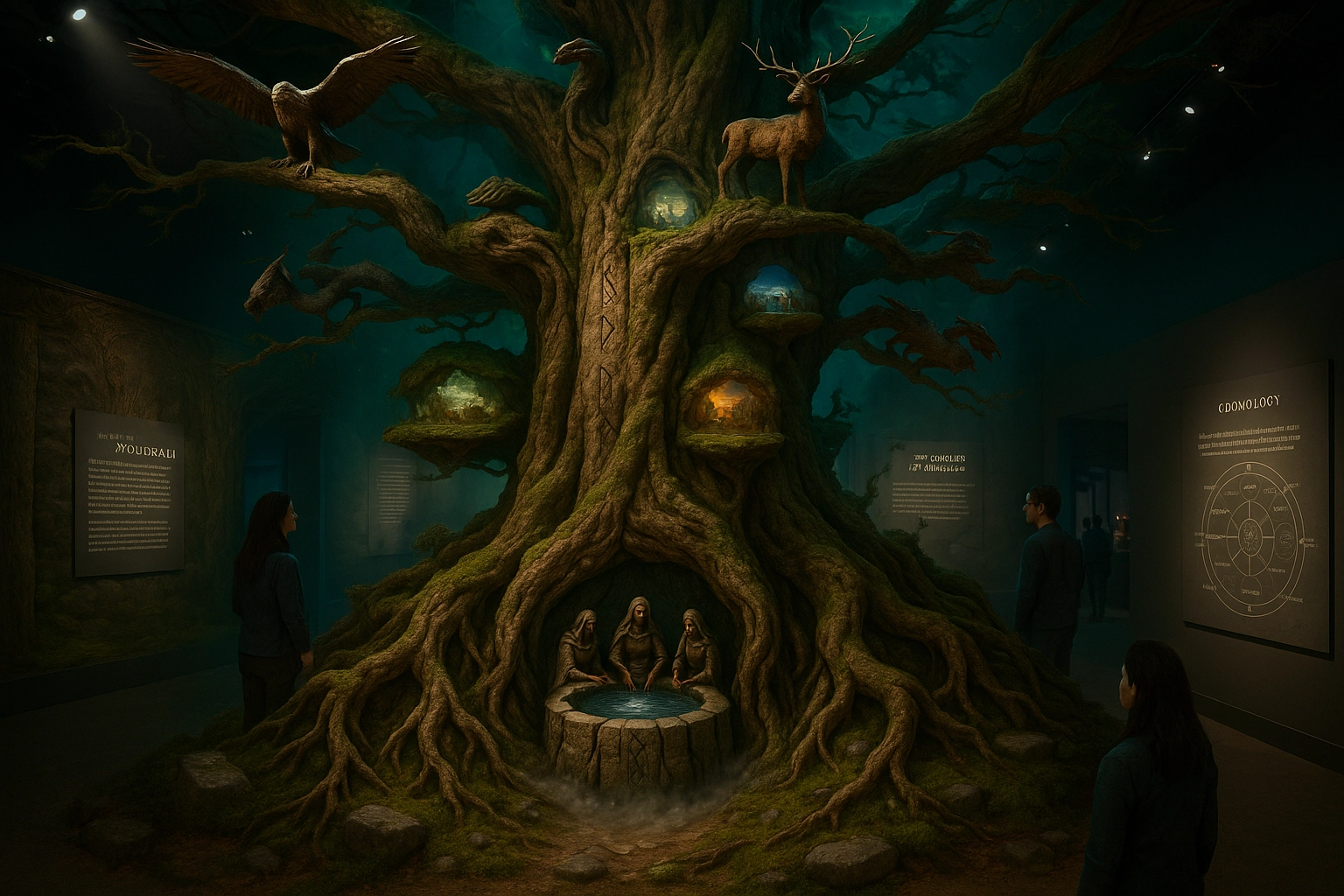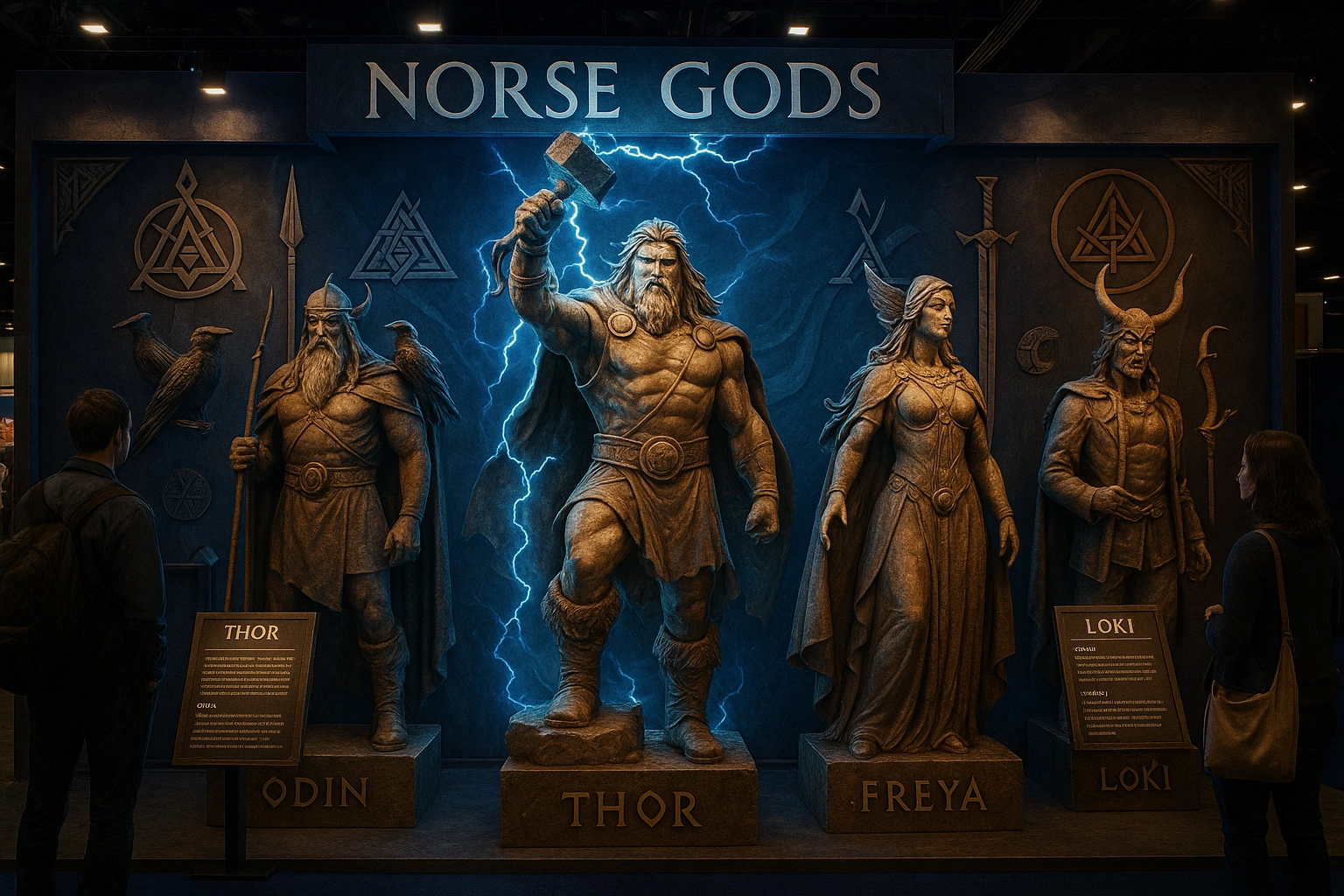Norse Mythology Exhibition
Discover the epic legends and profound wisdom of Norse Mythology through our immersive exhibition experience
Exhibition Layout & Experience

Exhibition Floor Plan
Interactive layout showing Valhalla hall, Yggdrasil tree display, and runic stone circle

Main Exhibition Hall
Featuring Viking artifacts, mythological displays, and interactive storytelling areas

Sacred Rune Circle
Ancient runic stones arranged in sacred circle symbolizing the Nine Realms of Yggdrasil
Historical Origins
Norse Mythology developed among the Germanic peoples of Scandinavia, especially Norway, Sweden, and Denmark, from the early centuries CE. Its roots stretch back to prehistoric Indo-European beliefs, evolving over centuries through oral tradition until written down in Iceland during the 13th century.
Emergence & Formation
The mythology arose organically in the Viking Age (ca. 800–1100 CE), shaped by the social, environmental, and martial culture of the Norse peoples. Myths were transmitted orally by skalds (poets) and became central to religious rituals, worldview, and identity until Christianization.
Key Figures & Deities
Odin - The All-Father
God of wisdom, war, and poetry; ruler of Asgard and seeker of knowledge.
Thor - Thunder God
God of thunder and protection; wielder of Mjölnir, defender of gods and humans.
Freya - Love & Magic
Goddess of love, fertility, and magic; leader of the Vanir gods.
Core Concepts & Beliefs
Yggdrasil
The World Tree connecting the Nine Realms of existence.
Wyrd (Fate)
Destiny woven by the Norns, inescapable for gods and mortals.
Ragnarok
The prophesied end of the world and rebirth of the cosmos.
Valhalla
Warrior's afterlife for those who die bravely in battle.
Core Principles
Courage & Fearlessness
Bravery in life and battle, facing destiny with honor.
Loyalty to Kin
Unwavering devotion to family and community bonds.
Sacred Oaths
Hospitality and oaths as sacred, unbreakable obligations.
Respect for Fate
Acceptance of wyrd while striving for honor and reputation.
Sacred Symbols
Mjölnir (Thor's Hammer)
Symbol of protection, power, and consecration.
Valknut
Three interlocked triangles associated with Odin and the afterlife.
Runes
Mystical alphabet for divination and communication with the divine.
Sacred Animals
Wolf (Fenrir), Ravens (Huginn & Muninn), Serpent (Jörmungandr).
Major Rituals & Ceremonies
Blót
Sacrificial feasts honoring gods, ancestors, and spirits.
Sumbel
Ritual drinking and oath-swearing ceremonies.
Seasonal Festivals
Yule (winter solstice), Midsummer, and harvest celebrations.
Divination Rituals
Rune-casting and seiðr (prophetic magic) practices.
Global Influence & Cultural Impact
Literary Influence
Norse mythology has profoundly influenced literature, art, and popular culture worldwide, especially through the Viking revival and modern fantasy genres, from Wagner's operas to Marvel's Thor.
Cultural Values
The mythology shaped the values, laws, and daily lives of Scandinavians during the Viking Age, influencing medieval literature, national identity, and the later Romantic movement.
Modern Revival
Norse mythology remains the foundation of the Ásatrú and Heathen movements—modern revivals of Norse paganism present in Scandinavia, North America, and beyond.
Important Spiritual Texts
Poetic Edda
13th-century Icelandic collection of mythological poems
Prose Edda
by Snorri Sturluson (ca. 1220), handbook of Norse mythology
Sagas of Icelanders
Legendary sagas preserving heroic tales and traditions
Sacred Places & Monuments
Uppsala Temple
Ancient temple site in Sweden, center of Norse worship
Oseberg Ship Burial
Magnificent Viking ship burial in Norway
Jelling Mounds
Royal burial mounds and runestones in Denmark
Borgund Stave Church
Example of Christian-Norse architectural syncretism
Memorable Norse Wisdom
"Cattle die, kinsmen die, you yourself will also die; but the word about you will never die, if you win a good reputation."— Hávamál (The Words of the High One), Poetic Edda